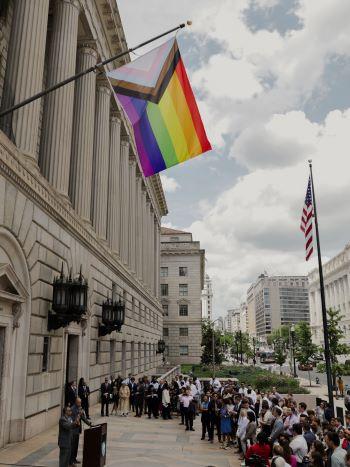What Pride Means to NTIA

Each June, Pride Month provides an occasion to celebrate progress made by the LGBTQI+ community and reflect on the work that remains to create a more equitable future. For individuals identifying as LGBTQI+, high-speed Internet access can unlock educational and economic opportunities, customized physical and mental health resources, and social and community connections.
By law, NTIA’s Internet For All efforts place a focus on reaching historically disadvantaged “covered populations.” The LGBTQI+ community overlaps with all the covered populations:
- the elderly
- incarcerated individuals
- veterans
- people with disabilities
- members of racial or ethnic minority groups
- rural residents
- people with a language barrier, including English language learners and those with low literacy levels
- people living in households with incomes not exceeding 150 percent of the federal poverty level.
This year, we are shining a light on the unique ways high-speed Internet access can open doors – both for individuals identifying as LGBTQI+ and their friends and families – to realize a more equitable tomorrow. Whether at home, school, the workplace, or accessing health care, information and tools enable full participation and inclusion in today’s digitally driven society.
High-Speed Internet Access Builds Bridges
Promoting an Inclusive Learning Environment
Ensuring that all students can learn and be themselves requires creating a safe and welcoming community. The Department of Education provides resources to ensure schools are inclusive and nondiscriminatory including toolkits, fact sheets, and up to date Title IX guidelines. High-speed Internet access places these resources at the fingertips of students, families, and school staff.
Creating a Welcoming Workplace
As LGBTQI+ individuals enter the workplace, some are still exploring their identity in the workplace or report feeling unfair treatment. The Department of Labor connects LGBTQI+ individuals to economic opportunities and promotes information sharing to make the workplace a welcoming place for jobseekers and workers. DOL’s recent round up of policies and resources aims to support an inclusive environment at work.
Providing and Accessing Appropriate Healthcare
LGBTQI+ individuals may face unique challenges when accessing healthcare, including geographic isolation, limited resources, or discrimination from providers. With access to high-speed Internet service, LGBTQI+ patients can research and pursue care options that would otherwise be unavailable to access locally. Health care workers can access research and best practices to provide welcoming and affirmative care for LGBTQI+ patients. The Department of Health and Human Services (HHS) works to ensure LGBTQI+ individuals, families, and communities receive equal access to health care. HHS seeks to close existing gaps in care by educating both patients and providers.
Building Safe Virtual Communities
Social connection can be just as critical for those feeling isolated in their immediate community. Dating back to the 1970s and 80s, online "bulletin board systems” allowed LGBTQI+ individuals to explore their identities anonymously, message other users with questions and shared experiences, and find community in the virtual world. High-speed Internet access continues to provide outlets for LGBTQI+ individuals to connect with one another and provide peer support.
"Growing up in my family, the promise and safety of the LGBTQ+ community was not readily available in-person. However, I was able to discover that world online."
- Lukas Pietrzak, NTIA
At the same time, research shows that LGBTQI+ youth are more likely to encounter online bullying. Both HHS and Department of Education provide information to build students’ digital health, safety, and citizenship, resulting in a safer Internet for all. Online resources help young people as they seek to understand and express their gender identity and sexual orientation. Developmentally appropriate resources provide a safe outlet for young people to learn, and for families and communities to create a safe and inclusive space.
Internet For All Amplifies “Pride in Progress”
The Department of Commerce’s 2024 theme “Pride in Progress” acknowledges the history, challenges, and achievements of those who have fought and continue to fight for LGBTQI+ inclusion, belonging, and equality. Through the Internet for All initiative, NTIA partners with states, territories, and other stakeholders to provide LGBTQI+ individuals with the connections and tools they need to thrive.
You can learn more about efforts in your community by visiting InternetForAll.gov.

